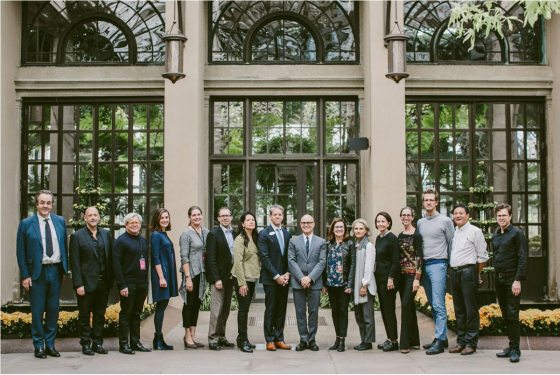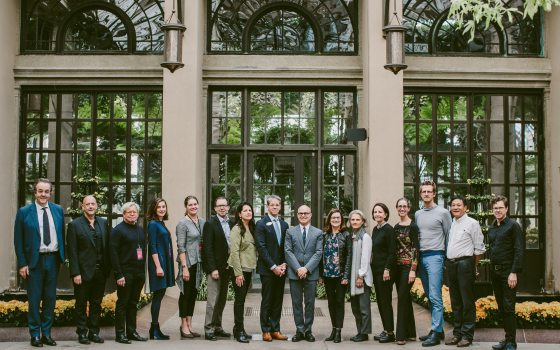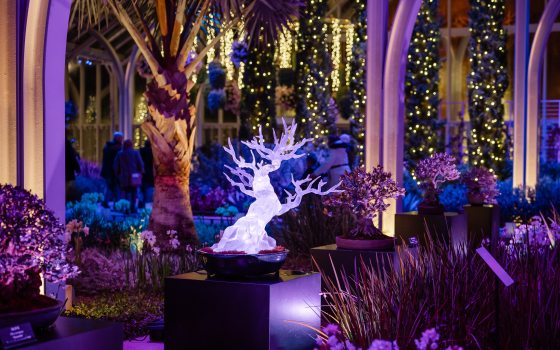One of the pleasures of organizing a convening like Designing Water, which happened last week at Longwood, is that—by setting up a theme of disciplinary concerns, a framework for discussing them, and gathering smart and talented people—something great unfolds. Usually, hopefully, you wind up with a conversation that is different from the one you imagined because of all the intelligence in the room.
This convening did just that.

The Designing Water speakers, from left to right: Christophe Girot, Chris Reed, James A. Garland, Sarah Weidner Astheimer, Nina-Marie E. Lister, Michael G. Lee, Julia Czerniak, Paul B. Redman, Mark Robbins, Mary Margaret Jones, Dorothée Imbert, Anita Berrizbeitia, Catherine Seavitt Nordenson, Kristian Koreman, Kongjian Yu, and Tilman Latz.
Christophe Girot’s keynote lecture set a tone of both optimism and alarm for designing water in the future, and for the presentations that followed. One of the most striking aspects of his provocative talk was a point cloud animation and sound recording simulation of the Morterastch Glacier in Switzerland, literally melting. Letting the ‘ice speak’ to all of us was a fitting call-to-arms for our world to develop—what Girot terms—an ‘aquatic intelligence.’
In our first session, People, Pleasure and other Populations, introduced in a lecture by Dorothée Imbert & moderated by Nina-Marie Lister, projects engaged and expanded on themes as diverse as water’s symbolic, social, and cultural functions; water as a source of pleasure and sensation, and water’s value for the health of humans and non-human species alike. Hargreaves Associates’s fountains at Discovery Green in Houston reinforced some of the more universal of designed water’s effects: how they surprise us, soothe our ears and cool us on hot days. STOSS’s University of Michigan quadrangle rehabilitation is unique in the way it utilizes interactive technologies to connect people to the natural cycles and dynamics of water. This was both mysterious and sensual. SCAPE’s work—always powerful in its activism—suggested ways to choreograph ecological, cultural, and political processes to rehabilitate water bodies. Imbert’s introductory framework brilliantly read very diverse historical projects that nonetheless suggest how, within each, are concerns for humans and biodiversity and access to water and conservation. Of particular note was the ecologically and socially complex network that supported the gardens of Versailles. As Imbert puts it, this “fish and the fowl” story is the other side of the more commonly known “splash and spectacle” one.
Our conversation about Designing Water was also contextualized by urgent issues surrounding it. Exacerbated by the geologic epoch in which we now live, the Anthropocene, these issues—from droughts to floods to contamination—are nothing less than alarming. In our second session, Shaping Civic Space: Challenges of the Anthropocene, introduced by Anita Berrizbeitia & moderated by Mason White, the presenters showed us how much design matters as we confront these pressing global concerns, with projects that dealt with too much, too little, and contaminated water. ZUS’s work on the Meadowpark in the Meadowlands advances a large natural reserve that not only offers flood protection but also creates social, infrastructural and spatial value. LATZ + Partners's Ariel Sharon Park in Tel Aviv uses novel technologies to retain a massive amount of water on site, while advancing spaces and places with unique geomorphological characteristics. Turenscape’s work on cleaning up contaminated water is inspired by the rich farming wisdom of China—including field making, irrigating, fertilizing, planting and harvesting—yielding multiple design experiments that help create a co-relationship between the performance of the landscape and its appearance. Each of these suggest that an aquatic intelligence must be both scientific and aesthetic. Berrizbeitia’s thoughtful framework lecture positioned these projects in a global context of political and social inequity, ethics, and governance. Berrizbeitia argued that the best contemporary practices for designing water, “hybrid approaches,” combine functionality with narrative, strong visual identity and symbolic references. This is certainly a way forward.
Undergirding the design and effects of water features and systems is the technology that enables it—of engineering that regulates water transfer, volume, flow, and purity; of design that enables extraordinary and diverse spectacles and effects; of advanced digital modeling and fabrication that afford experimentation in both appearance & performance. In the final session, Technology, Innovation and the Future, introduced by Michael Lee and moderated by Charles Waldheim, the designers expanded on these themes. In projects such as Tongva Park in Santa Monica, Field Operations demonstrated how digital modeling can serve both function and aesthetics. Catherine Seavitt Nordenson’s presentation explored, within Jamaica Bay, the United States Army Corps of Engineers new focus on developing nature-based features as viable coastal storm risk reduction techniques. I found the three complementary design strategies she outlined, especially the “atoll terrace / island motor” full of potential for creating resilient urban ecological systems. James Garland uses technology in his work in the service of poetic intent, which we all witnessed in the Main Fountain Garden show the opening night of the event. Michael Lee’s talk illuminated this work by providing the historical grounding of our current situation.
Finally, the lectures during lunch— by Longwood biographer Colvin Randall and the landscape architect of the Main Fountain Garden redesign, West 8—positioned the remarkable designed water of Longwood not only in a continuum of Pierre du Pont’s own “Grand Tour” of significant gardens and World’s Fair sites in both Western Europe and America, but also shed light on the culture of celebration, beauty, and delight that we all experienced at Longwood for the two days we spent there.
I left Designing Water with a clearer idea of what aquatic intelligence might be, and I know for sure that we as designers need to think differently about how we teach, how we practice, and how we envision our work. We all need to be activists and build not just projects, but awareness: of climate change and of the need to develop a contemporary attitude towards water that drives our work. We need to speak up about the alarming state of world in which we live.
After all, the melting glacier does.


